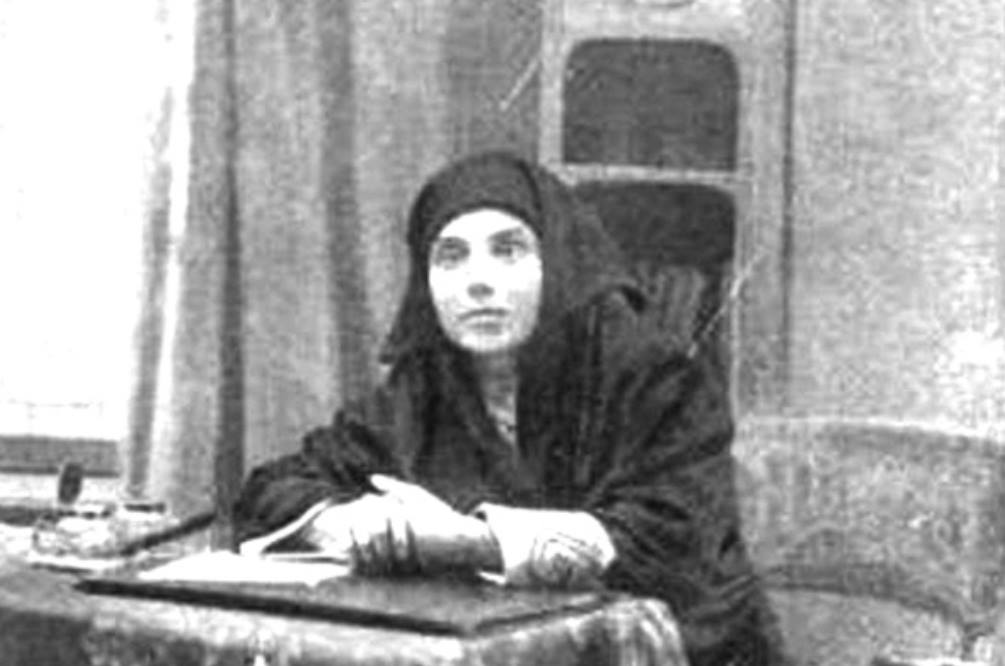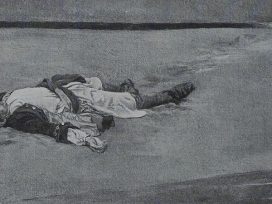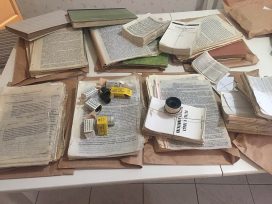I remember: I first came across Yaşar Nezihe’s name in the anthology Turkey’s New Poets by Martin Hartmann, published by Der Neue Orient GmbH in 1919. But for unknown reasons it was after a performance of one of her poems ‘Mecnûn İsen Ey Dîl Sana Leylâ mı Bulunmaz?’ (If You Are Mecnun Oh Tongue Cannot Leyla Be Found for You?) by the minstrel Kazancı Bedih from Urfa that I really began to track her down.
She was fruitful ‘material’ for a writer: the first Muslim woman to have her unveiled photograph published in the Ottoman press; the first socialist poet to compose a Turkish poem about May 1; the first woman to write for Aydınlık, the journal of the Communist Party of Turkey…

Photography of Yaşar Nezihe published in Kadınlar Dünyası (Women’s World) in 1913. This was the first photograph ever to show a woman without a veil in Turkish history. In the photo, Nezihe’s face is visible, but the rest of her burqa remains.
Mine was just a birds-eye, cursory, superficial overview. What was it that held me, who was keeping me? How to ‘read’ without exaggeration this person described as ‘imprisoned throughout her life in a place beyond language, subjected to control of identity and body’, this person who went by the name of Mazlume, Mahmure, even Mehcure? Should the reading start with Jaschar Nezihe Hanum (as Hartmann called her), or with Yaşar Zeliha? I suppose it should start at the beginning, the very beginning.
In the records, her date of birth is given as 17 January 1297. In other words, 29 January 1882 in the Gregorian calendar. Asım Bezirci, a writer known for his attention to detail, differs however: he says she was born on 13 January 1882 ‘on a stormy night in a derelict house on Baruthane Street in the Şehremini district of Istanbul’. Hartmann says 14 January 1882. Taha Toros 17 January 1880. İsmail Hikmet Ertaylan does not give a date, and makes do with January 1880. Well, if we don’t have a day or year, at least we can agree on January; that is something.
The confusions are not limited to date of birth. Hartmann, Bezirci and Ertaylan all say the poet was born on Baruthane Hill in Şehremini district. But the majority insist on Silivrikapi and Hünkarbeğendi Street, also known as Hünkar İmami. Why, I wonder? Could the street name have changed? According to the sources I examine in a short time, it didn’t change. And of course there’s no birth certificate to check either.
Tempests awakened
Her father Kadri was a porter at the Weigh House in Şehremaneti and reportedly ‘an ignorant, wretched, drunken, coarse and unkind man’. He would ‘take his monthly salary and spend it on drink, while his wife and children at home endured pain and misery and suffered the most painful, most tearful, deepest and blackest pains of hunger and need.’
Her mother was Kaya, of Tatar stock from Bahçesary. Sometimes she would answer to Eda. Yaşar Zeliha was just six years old on the day when this woman, ‘who spent sixteen full years quarrelling and fighting in the single combat she was forced to wage with life to feed children on one side and struggle with the home on the other, finally collapsed and departed, unable to withstand as an unlucky tuberculosis spread in her thoroughly exhausted and rotten body and bones’ (Ertaylan).
As the third and only surviving child of a five-child family, the unfortunate Yaşar Zeliha was taken under the wing of Kadri’s Aunt Zehra, who was unable to walk because of either age or injury, is described by some sources as ‘half-mad’, who never married out of loyalty to a childhood love, and who wanted to spare her the early death that befell her siblings. Nevertheless, it was neighbours who cared most for Yaşar Zeliha. Despite that, her aunt did not omit to read her the stories of Leyla and Mecnun, Ferhat and Sirin, Kerem and Asli. These readings, according to Bezirci, ‘awoke tempests’ within the young girl, and according to Ertaylan ‘stoked the desire to read’.
Meanwhile, she wanted to be enrolled at school rather than play with the boys on the street and appealed to her father. ‘This inconsiderate and heartless father, an ignorant and wretched brute, rather than welcoming and encouraging this laudable desire in his daughter, instead responded with scorn and threats, even beatings.’ But none of the scolding and threats worked; she told the head of the Kapıağasi İbrahim Primary School of her desire and span a yarn about poverty and orphanhood. The head could not refuse a girl with the impulse and strength to learn. Discovering this adventure, her cruel father, like an enraged hero of a Kemalletin Tuğcu novel, beat her and dragged her out of the house by her hair: ‘The poor girl spent many nights in the homes of neighbours and lived the life of a parasite.’
She ‘came herself’
How much of this physical and emotional cruelty can a person endure? But out of necessity and unwillingly, she returned home. Her father did not object and opened the doors with at least some civility. And so she attended at most a year of primary schooling. Bezirci tells us that it was at this stage that her father gave Yaşar Zeliha the nickname ‘The one who came herself’. But Hakkı Tarık Us says that the nickname was given by the school director to the small girl who came to school of her own free will.
This is the sum of her educational life; ‘anything beyond that she obtained solely through her own personal endeavour and willpower’ (Ertaylan). She taught herself needlework and read romantic novels (Bezirci). And she inclined towards poetry. ‘I could not rid myself of the desire to read. I had no money at all. I collected hibiscus and camomile seeds from the riverbanks and sold them to herbalists. Forty coins I gave to the overseer. That was all the education I received. Literature and poetry I taught myself.’
At the age of just 14, the poem (or is it a song?) that she wrote in a passion and sent off to Malumat under the name of Mazlume was immediately printed:
‘In the fire of passion I constantly cry out/You cause of my woe I need the cure from you.’
The inspiration for that song was Sergeant Hilmi, who patrolled the streets from the local police station. But the mutual love was brought to a sudden end by the father’s rejection.
Under exactly which pen name the song was written remains something of a mystery. According to one authority, ‘The “song” that starts with the couplet “In the fire of passion I constantly cry out/You cause of my woe I need the cure from you” was written under the name Mahmure’, while a second ‘Song’ starting with a different couplet was signed Mazlume and published underneath in the same issue of Malumat.
Your song is quite beautiful
Malumat was a weekly journal covering scientific, technical and literary matters, published during the reign of Abdülhamit II under the leadership of Fuad Bey and Artin Bey. It was alleged to have been directly supported by Abdülhamit as a counterweight to new literary movements such as Wealth of Knowledge.The publisher, chief editor and report was Mehmed Tahir, otherwise known as Baba Tahir.
The journal was notable for publishing both ‘Burhan-i Kudret’, the poem by a young man named Hasan Asaf that started the ‘abes-muktebes’ debate that gave birth to the Wealth of Knowledge movement, and also the article on ‘Our Poetry’ by Ali Ekrem that led to the break-up of the Wealth of Knowledge movement. And of course, for embracing amateur enthusiasts and for writing evaluations, often just a single line, to encourage poets they published… For instance, the note written to Yaşar Zeliha: ‘Your song is quite beautiful.’
Yaşar Zeliha, unable to obtain her first love Sergeant Hilmi, entered her first marriage in 1897 at the insistence of her now unemployed father to Atıf Zahir, to a clerk at a religious foundation who was 27 years her senior. ‘If at first promising happy days, this felicity soon proved to be a false dawn that quickly faded’ (Ertaylan). The reason for separation: Yaşar Zeliha’s inability to become pregnant. And he’d already been married three times with no children from any of them.
It is said that Yaşar Zeliha sometimes used the name ‘Yaşar Nezihe, daughter of Kadri the Weigher’ and changed her name to Yaşar Nezihe partly on the insistence of Atıf. His excellency did not approve of the poet’s name. With the passing of the Surname Law, in 1934 she added ‘Bükülmez’ (Unbending) to her name…
Her second marriage was to the engineer Fevzi. During this five-and-a-half year marriage Yaşar Nezihe had three sons, Sedat, Suat and Vedat. However, Fevzi’s debauchery, his search for happiness outside marriage and his tendency to abandon his wife and children in times of need led to Sedat and Suat dying of hunger. This was too much and the couple separated.
Five years passed. News came from Fevzi the engineer. He was severely ill; he wanted to see her for a last time. Yaşar Nezihe went without hesitation and sat at the side of his bed. Fevzi asked for a drink of water. After sipping he looked at her with teary eyes and said, ‘Forgive me Nezihe!’ She thought for a while about five-and-a-half years of agony and the loss of two sons full of potential to his neglect, and gave the answer from a heart scarred by pain: ‘I cannot forgive!’ Three seconds later Fevzi closed his eyes on life, his hand cooling in Yaşar Nezihe’s palm…
The 50-day marriage
The soul that here did not bend was not always able to display such perseverance; twice she approached the verge of suicide but failed in the attempts. Each time it was her son Vedat who bound her to life.
After suffering many a betrayal, Yaşar Nezihe rolled on down life’s thorny roads; until the writer Yusuf Niyazi Erdem, to whom she’d been engaged prior to her first husband, re-entered her life. As their contact expanded, both felt the need to marry. However their marriage, which had once been prevented by her father, lasted about 50 days.
It is useful at this point to allow Yaşar Nezihe to speak:
‘Yusuf Niyazi, to whom I was once engaged, 13 years later asked for my hand! He would not give in. My heart was burned out by the first two marriages. But I said to myself, I should try my luck for a third time! Oh, if only I had not! We set our wedding for 10 July 1912, the fourth anniversary of the Second Constitutional Period, as an auspicious sign for our new household. We boarded a steamer in Istanbul to head to Niyazi’s posting in Cide. The man started his womanising even on board the steamer. Twelve days after landing in Cide he brought home two women he had divorced earlier. Entirely calmly he said, ‘We will all live together!’ When I married him on July 10 I had no idea I would be his tenth wife! I managed to hold out only fifty days. I returned to Istanbul and applied to the courts. The man swore he would not divorce. With difficulty I divorced him. In my three marriages I have been disappointed. From none of them I have I received the slightest monetary assistance or alimony or compensation, neither during the marriage nor after divorce.’
Divorce did not mean all contact would be cut, and Yusuf Niyazi and Yaşar Nezihe corresponded for a long, surprisingly long, time. It was more that Yusuf Niyazi wrote and Yaşar Nezihe did not deny him a response. Additionally, she appears as the chief poet in the journal Nazikter that her former husband published in 193 editions between 1917 and 1928. He also published her poetry and letters in the handwritten Çiçek.
In the wake of the death of her sons, the death of her father and uncle left her deeply alone. She devoted herself to Vedat: ‘She worked night and day to raise a son in whose future she placed all her hopes, she washed the bachelors’ clothes, sewed the shirts of soldiers and the poor, and earned a living through the work of her hands and the sweat of her brow’ (Ertaylan). And she did not abandon poetry, no matter what. She appears in almost every edition of Women’s World, the first magazine devoted to women. The cover of the 124th edition was devoted to her. ‘To the Great Poet, Mrs Yaşar Nezihe.’
A bunch of violets
The years were not kind to Yaşar Nezihe: the Balkan War brought with it not just social and cultural destruction and collapses, but also economic and spiritual crises. Reading and replying to the letters of those who would soon go to war became a source of income in these years:
‘For 17 years I worked for Welfare Association, then in later years for the Red Crescent. I did sewing in the Şark Goods Market. At the Mint, I sewed ribbons for Independence medals. I often worked at night to the dull light of a number five petrol lamp to find myself in the morning still at the embroidery frame. In addition I secured myself a side income through my pen. Whether it was the First World War or the War of Independence, with my inkwell in hand I earned a living by writing letters to the husbands, sons and brothers of my neighbours who were at the front.’
The poet’s description and skill that was on display in the 1913 collection Bir Deste Meneke (A Bunch of Violets) was little noticed amid the depression. It only managed to reach the libraries of a few friends and relatives. Some thought it had been issued hastily; that the poems chosen for the volume had not achieved the right maturity and coherence.
She continued to be plagued by irregularities. The compensation for her father, who died of cholera after 45 years in the civil service, should have been paid to her from the age of 22, but was only registered at 34. And what a payment: 42.5 kuruş! Yaşar Nezihe wrote letters to the newspapers to protest this late and extremely small sum:
‘It is impossible to live on this money. I am an elderly lady and can no longer work as I once did. My eyes do not see. Without oil, not even the most powerful machines can work. My life has always been one of hunger and pain. It is impossible to tolerate this situation much longer. If one day news spreads of my passing, everyone may be sure that I died of hunger.’
The poet’s cries were heard by İsmail Muştak, a reporter for Tanin newspaper, and the next day he devoted a column to the issue. In a piece entitled ‘A 40 Kuruş Orphan Allowance’, he saw this payment, which less than a porter’s daily wage, as a pitiful case and issued the reproach that ‘you cannot drink two glasses of water for 42.5 kuruş.’ But no one was listening.
Persecution and invisibility
Under these circumstances, the publication of the poem ‘May 1’ in Aydinlik in May 1923 was greeted with some awareness and enthusiasm. It called for organised struggle and workers’ strikes. A few issues later, readers of the magazine were greeted by the poem ‘Red Roses’. That year, the Typesetters Association was in dispute with the newspaper owners and went on strike. Yaşar Nezihe wrote the poem ‘To The Newspaper Owners’ in support of the strike. Appearing in Haber on 18 September 1923, it defended workers against mistreatment.
A year later, a new May 1 poem, in the same mode as the first, was published in Aydinlik. And the sirens began to sound for Yaşar Nezihe. On June 3 she was detained for ‘communism’ for publishing poems in Aydinlik, being a member of the Workers Society and supporting strikes, and for once (in 1920) having sent a telegram to Ankara complaining of hunger. Held in the station for a night and then released, she was kept under surveillance for a long time. According to one source, she was cleared due to the influence Nezihe, wife of Muhittin, an Ottoman-era feminist.
In 1924 (or 1925) the collection Feryadlarim (My Lamentations) was published with the encouragement and support of Rifat Necdet. It met with scant praise despite its particular expression of disappointment and deep pain. As the days passed, she became invisible in the magazines. In his anthology he compiled (Our Women Poets and Reporters), Murat Uraz came to the conclusion she had died in 1934. In fact, around that time, Taha Toros had interviewed the poet for his Yedigün.
Meanwhile Yaşar Nezihe had handed over her Şiir Defter (Poetry Notebook) to Taha Toros; inside it were a few documents along with poems reminiscent of a bride arguing with a mother-in-law. These are signs that she could not share her son Vedat with his wife Hasibe. Despite the passing of almost half a century, these remain unpublished.
Many years later, in the second half of the 1960s, Asım Bezirci was preparing a study on ‘the Left in our poetry’. Acting on the directions of the late Neriman Hikmet, he found his way to Vedat’s home in Göztepe and had the chance to interview Yaşar Nezihe Bükülmez. When they met, the poet was 86. The son was not at home that day. Hasibe opened the door. Yaşar Nezihe’s hands trembled but her mind was sharp as a tack. So as not to tire her, he only asked a few questions. Some time later he called back, hoping to speak again and learned that Yaşar Nezihe and her son had died.
It is a little odd, and very ironic, that Bekir Yildiz should have been prosecuted for the story ‘Olü Soğumadan’ (Before the Body Cooled), which he wrote for Yaşar Nezihe, who died in 1971. And it is more than absurd that despite the writer being amnestied in 1974, the story remains imprisoned.
What is it we say? That’s how it is.







